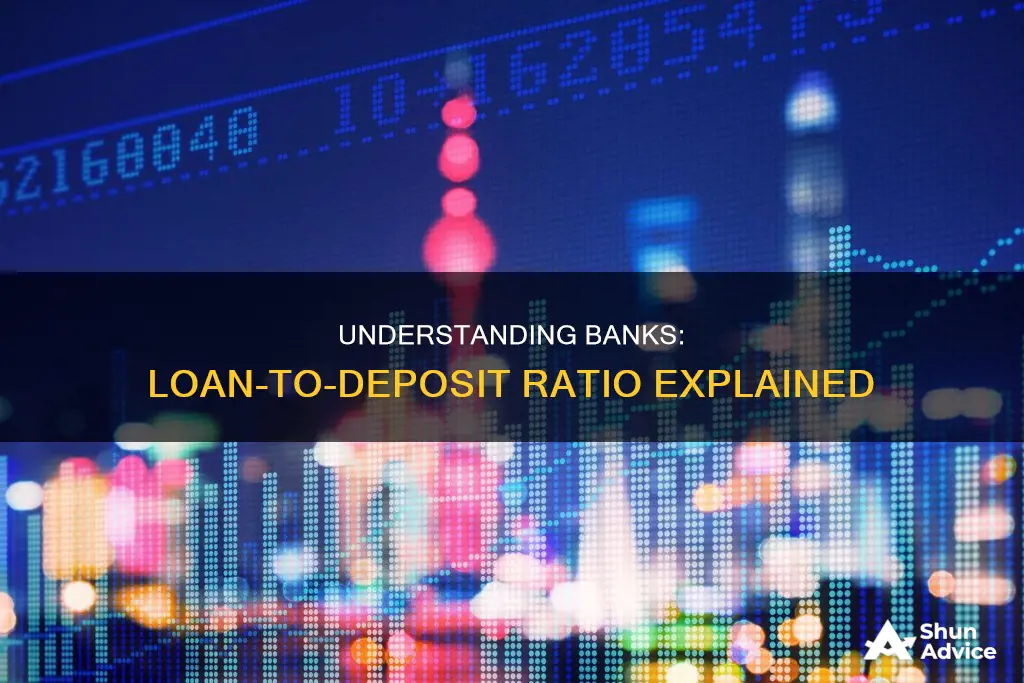
The loan-to-deposit ratio (LDR) is a financial metric used to assess a bank's liquidity and credit risk by comparing its total loans to its total deposits. It is calculated by dividing a bank's total amount of loans by its total amount of deposits and is expressed as a percentage. A high LDR indicates that a bank may be relying heavily on deposits to fund loans, increasing profits but also reducing cash reserves available to cover withdrawals, unexpected funding needs, and reserve requirements. This can result in higher risk exposure for the bank, particularly during periods of economic instability. Conversely, banks with low LTD ratios might have lower interest income and lower earnings. The LDR is a useful tool for evaluating bank health, but it should be considered alongside other financial metrics as it does not account for loan quality or funding sources.
| Characteristics | Values |
|---|---|
| Definition | The loan-to-deposit ratio (LDR) is a financial metric that compares a bank's total loans to its total deposits. |
| Calculation | The LDR is calculated by dividing a bank's total amount of loans by its total amount of deposits and is expressed as a percentage. |
| Purpose | The LDR is used to assess a bank's liquidity and credit risk, providing insight into how much risk a bank has taken on and its ability to meet liquidity requirements. |
| Risk Assessment | A high LDR suggests a bank is taking on more risk as it has less cash reserve to cover unexpected losses and may be relying heavily on borrowing from other institutions. |
| Limitations | The LDR does not account for loan quality or funding sources and is not suitable for comparing dissimilar banks. |
| Regulatory Impact | The LDR is influenced by economic conditions and regulatory requirements, such as monetary policy and interest rates. |
| Historical Context | During the 2008 financial crisis, banks with high LDRs and reliance on wholesale funding were more vulnerable to market shocks. |
| Bank Health | A bank with an LDR greater than 100% is notable as it indicates a potential risk to the bank's financial health if deposits decline or loan defaults occur. |
What You'll Learn

Assessing a bank's liquidity
Liquidity is crucial for banks; a lack of it can lead to a bank's quick failure. The loan-to-deposit ratio (LDR) is a useful metric for evaluating a bank's health and credit markets. It measures the proportion of a bank's total loans to its total deposits. A high LDR suggests that the bank is taking on more risk because it has less cash on hand to cover unexpected losses. A bank with an LDR greater than 100% is noteworthy because a decline in deposits or loan defaults could threaten its viability.
To assess a bank's liquidity, investors can check the liquidity coverage ratio (LCR) in its quarterly reports. The LCR is calculated by dividing high-quality liquid assets (HQLA) by total net cash outflow. HQLA typically consists of US Treasury securities and actual cash. The total net cash outflow is determined by calculating the 30-day total of all withdrawals from deposit accounts, cash outflows to fund loans, cash expenses from the bank's operations, and cash outflows from contractual obligations.
Another tool for liquidity analysis is cash flow projection statements, which can range from simple spreadsheets to detailed reports, depending on the complexity and sophistication of the institution. Institutions should ensure that reasonable and appropriate assumptions are used in assessing the liquidity risk of complex instruments, assets, liabilities, and off-balance-sheet positions with uncertain cash flows, market values, or maturities.
A Contingency Funding Plan (CFP) is another important component of liquidity management. A robust CFP identifies relevant bank-specific and systemic stress events for which an institution should prepare. Stress events may include changes in credit ratings, deterioration in asset quality, unplanned asset growth, operating losses, or negative media coverage. Institutions can use the different stages of a liquidity stress event to design early warning indicators, assess potential funding needs, and specify comprehensive action plans.
Is Grace Loan Advance a Safe Bet?
You may want to see also

Evaluating a bank's health
Regulatory Oversight and Independent Ratings
Independent agencies like Moody's, Standard & Poor's (S&P), and Fitch Ratings assess banks' performance and risk profiles. These agencies use different criteria and scales to rate banks, with S&P, for example, using letter grades, where AAA is the highest rating, indicating strong financial health. These ratings provide insights into a bank's ability to meet its obligations, withstand economic downturns, and protect its depositors.
Loan-to-Deposit Ratio (LDR)
The LDR is a critical metric that measures the proportion of a bank's total loans to its total deposits. A high LDR indicates that a bank may be taking on more risk, as it has fewer cash reserves to cover unexpected losses. During periods of economic instability, a high LDR may suggest that the bank relies heavily on borrowing from other institutions to fund its lending activities.
Capital Levels and Ratios
A bank with strong capital levels is generally considered healthier. The Bank of International Settlements categorizes capital into Tier 1 (primary measure) and Tier 2 (supplementary capital). Tier 1 capital includes shareholder equity and retained earnings, while Tier 2 includes revalued and undisclosed reserves. The capital adequacy ratio (CAR) is calculated using these tiers and indicates if a bank has sufficient capital to cover potential losses from lending and investments.
Net Interest Margin (NIM)
NIM measures the spread between the interest rate a bank earns on loans and the interest it pays to depositors. A higher NIM generally indicates stronger profit potential, although it also depends on the current interest rate environment and the bank's business model. Historically, banks have averaged a NIM of 3-4%, and a margin lower than 3% may be a cause for concern.
Economic Value of Equity (EVE)
EVE measures the long-term value of a bank's equity, considering the present value of its assets and liabilities. It indicates the amount of equity left after liquidating all assets and liabilities and meeting its obligations. EVE is crucial in assessing a bank's ability to manage interest rate risk and is a metric mandated by the U.S. for regular appraisal.
Financial Statements and Risk Management
A bank's financial statements, including its balance sheet, income statement, and cash flow statement, provide valuable insights into its financial health. Additionally, assessing a bank's risk management methods is essential, as sound risk management practices contribute to its overall financial health and the stability of the global financial system.
Citrus Loans: Safe or Risky Business?
You may want to see also

Identifying potential pockets of risk
The loan-to-deposit ratio (LDR) is a vital indicator in banking that reflects the balance between a bank's loan portfolio and deposit base. It is a useful metric for evaluating a bank's health and credit markets. By analyzing the LDR, stakeholders can assess a bank's risk management strategies and profitability.
A high LDR suggests that a bank is lending out a significant portion of its deposits, indicating aggressive lending practices. This can be risky as the bank has less cash reserve to cover unexpected losses and may need to borrow money from other institutions, adding interest costs that eat into profit margins. A decline in deposits or loan defaults could also adversely impact the bank's financial health.
A low LDR, on the other hand, may signify underutilization of deposits or conservative lending behavior. While this provides more security during financial stress, it may hinder revenue-generating opportunities.
To identify potential pockets of risk, traditional wisdom suggests that an LDR greater than 100% is noteworthy. In 2022, 8% of banks with assets greater than $50 billion had an LDR greater than 100%, while 16% of banks in the $10 to $50 billion category did. The two size categories with the highest median LDR are banks with assets between $1 billion and $10 billion, and $10 billion to $50 billion. While the median LDRs are within the "comfort" range of 70% to 90%, the deposit drawdown at some small and regional banks may have shifted the LDR for some institutions into uncomfortable territory.
Overall, maintaining an optimal LDR is critical for sustainable growth and stability in the banking sector. Banks must balance liquidity and profitability, ensuring sufficient liquidity for short-term obligations while maximizing profitability through lending activities.
Understanding Caveat Loans: Risky Business?
You may want to see also

Comparing customer deposits to wholesale funding
The loan-to-deposit ratio (LDR) is a useful tool for evaluating a bank's health and credit markets. It measures a bank's liquidity and credit risk, indicating its ability to pay depositors in a financial crunch and how efficiently it uses its funds to make money. The LDR is calculated by dividing a bank's total loans by its total deposits, giving a percentage that indicates how much of its deposits are being lent out. A high LDR suggests a bank is taking on more risk, with lower profit margins and more debt, as it has less cash reserve and may rely on borrowing from other institutions to fund its lending activities.
Customer deposits are considered "good" for a bank's funding strategy, while wholesale funding is deemed "bad". Customer deposits are seen as sticky, as they are supported by underlying economic activity and are less transient. In contrast, wholesale funding is provided by strangers who are not customers and are lending to the bank for their own investment purposes. This funding is more transient and less reliable.
The LDR is a simple risk measure that tries to predict how a bank's funding base will react in times of stress. It is not always a perfect measure, as it does not account for the diversity of real-world funding resilience within each category. However, it can provide insight into a bank's financial health and stability, especially during periods of economic instability.
For example, during the 2008 financial crisis, banks with high LDRs and a greater reliance on wholesale funding, such as Northern Rock, were more prone to failure due to their risky funding base. In contrast, banks with lower LDRs and a stronger focus on customer deposits may have more stable funding sources.
The LDR can also indicate how efficiently a bank is attracting and retaining customers. If a bank is losing deposits or depositors, it will have less money to lend and lower income. Balancing the LDR is a challenge for bank CEOs, as they must ensure sufficient reserves in the event of a crisis while also generating enough interest income.
Tribal Loans: Legal Status in Illinois Explained
You may want to see also

Anticipating a bank's performance in times of stress
The loan-to-deposit ratio (LDR) is a useful metric for evaluating a bank's performance and anticipating how it might fare in times of stress. It measures the proportion of a bank's total loans to its total deposits, providing insight into the bank's liquidity and risk level. A high LDR indicates that a bank may be taking on more risk by having fewer cash reserves to cover unexpected losses, while a low LDR suggests that a bank may not be using its deposits efficiently and could have lower earnings.
In times of financial stress or an economic downturn, a low LDR is advantageous as it provides more security. The bank will have more liquidity to meet its obligations and will be less reliant on borrowing from other institutions, reducing its overall risk. On the other hand, a high LDR could indicate that a bank is in danger of running short of liquidity, as seen with the collapse of Silicon Valley Bank and Signature Bank. This can have a significant impact on the bank's financial health and even threaten its viability.
To maintain a healthy LDR, banks must balance lending and deposits carefully. If a bank lends too much, it risks having insufficient reserves in a crisis, while lending too little can result in lower interest income and reduced profitability. Various factors influence LDRs, including economic conditions, loan demand, investor behaviour, and regulatory requirements.
To assess a bank's performance and preparedness for challenging periods, investors and regulators examine bank data, including LDRs. This analysis helps identify pockets of risk and ensure compliance with regulations, such as the Riegle-Neal Interstate Banking and Branching Efficiency Act of 1994. Stress testing has also become a critical tool for evaluating a bank's resilience, particularly regarding liquidity, as highlighted by the COVID-induced depression and the Great Financial Crisis.
In summary, the LDR is a critical indicator for anticipating a bank's performance in times of stress. It provides insights into liquidity, risk exposure, and overall financial health. By understanding the LDR and its implications, investors, regulators, and bank management can make informed decisions to safeguard the bank's stability and ensure it is well-positioned to weather economic downturns and unexpected losses.
Becoming a Loan Signing Agent: Maryland Requirements
You may want to see also
Frequently asked questions
The loan-to-deposit ratio (LDR) is a financial metric that compares a bank's total loans to its total deposits. It is used to assess a bank's liquidity and credit risk. A high LDR means the bank may be relying heavily on its deposits to fund loans, increasing profits but also reducing cash reserves available to cover withdrawals, unexpected funding needs, and reserve requirements.
The loan-to-deposit ratio is calculated by dividing a bank's total amount of loans by its total amount of deposits, and this figure is expressed as a percentage.
A loan-to-deposit ratio of over 100% indicates that a bank's loan book is greater than its deposit base. This suggests that the bank is taking on more risk, as it may be relying on borrowing from other institutions to fund its lending activities.







